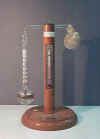
 SM119
Daniellís hygrometer circa
1960 Heat
SM119
Daniellís hygrometer circa
1960 Heat
This is an apparatus relying on the dewpoint to measure humidity in the
air. It consists of
two glass bulbs connected by a glass tube bent at right angles twice.
One of the bulbs, which is at a lower level, is two thirds full
of ether and has a sensitive thermometer immersed in it.
The apparatus contains only ether or its vapour.
The other bulb, covered with muslin, is cooled by dropping ether
on the outside and letting it evaporate.
This causes ether from inside the lower bulb to distil inside the
cooled bulb causing the temperature of the lower bulb to fall.
When the temperature falls to the dewpoint, water from the
atmosphere condenses on the outside.
The dew is made more visible by means of a silvered ring on the
bulb. The temperature
at which dew first forms is noted and then the bulb is allowed to warm
up. The temperature
of the bulb when the dew disappears is again noted and the average is
the dewpoint. The
dewpoint can be converted into percent relative humidity at the ambient
temperature by using dewpoint / vapour pressure tables.
Sources of error in this apparatus are:
(a) Only
the surface of the ether is cooled so the thermometer might not give the
exact temperature.
(b) The ether
vapour from the cooling process might affect the ambient conditions.
(c) Bad
thermal conductivity of glass can cause an error in the dewpoint
reading.

![]()
 Museum
Museum
![]()
 SM119
Daniellís hygrometer circa
1960 Heat
SM119
Daniellís hygrometer circa
1960 Heat![]()